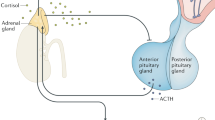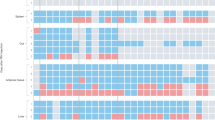Abstract
The brain and adrenal are critical control centers that maintain body homeostasis under basal and stress conditions, and orchestrate the body’s response to stress. It is noteworthy that patients with stress-related disorders exhibit increased vulnerability to mental illness, even years after the stress experience, which is able to generate long-term changes in the brain's architecture and function. High levels of glucocorticoids produced by the adrenal cortex of the stressed subject reduce neurogenesis, which contributes to the development of depression. In support of the brain–adrenal connection in stress, many (but not all) depressed patients have alterations in the components of the limbic-hypothalamic-pituitary-adrenal (LHPA) axis, with enlarged adrenal cortex and increased glucocorticoid levels. Other psychiatric disorders, such as post-traumatic stress disorder, bipolar disorder and depression, are also associated with abnormalities in hippocampal volume and hippocampal function. In addition, hippocampal lesions impair the regulation of the LHPA axis in stress response. Our knowledge of the functional connection between stress, brain function and adrenal has been further expanded by two recent, independent papers that elucidate the effects of stress on brain and adrenal stem cells, showing similarities in the way that the progenitor populations of these organs behave under stress, and shedding more light into the potential cellular and molecular mechanisms involved in the adaptation of tissues to stress.
This is a preview of subscription content, access via your institution
Access options
Subscribe to this journal
Receive 12 print issues and online access
$259.00 per year
only $21.58 per issue
Buy this article
- Purchase on Springer Link
- Instant access to full article PDF
Prices may be subject to local taxes which are calculated during checkout
Similar content being viewed by others
References
Berciano J, Lafarga M, Berciano M . Santiago Ramon y Cajal. Neurologia 2001; 16: 118–121.
Altman J . Are new neurons formed in the brains of adult mammals? Science 1962; 135: 1127–1128.
Rubin de Celis MF, Garcia-Martin R, Wittig D, Valencia GD, Enikolopov G, Funk RH et al. Multipotent glia-like stem cells mediate stress adaptation. Stem Cells 2015; 33: 2037–2051.
Chetty S, Friedman AR, Taravosh-Lahn K, Kirby ED, Mirescu C, Guo F et al. Stress and glucocorticoids promote oligodendrogenesis in the adult hippocampus. Mol Psychiatry 2014; 19: 1275–1283.
Malatesta P, Hartfuss E, Gotz M . Isolation of radial glial cells by fluorescent-activated cell sorting reveals a neuronal lineage. Development 2000; 127: 5253–5263.
Doetsch F, Caille I, Lim DA, Garcia-Verdugo JM, Alvarez-Buylla A . Subventricular zone astrocytes are neural stem cells in the adult mammalian brain. Cell 1999; 97: 703–716.
Fuentealba LC, Obernier K, Alvarez-Buylla A . Adult neural stem cells bridge their niche. Cell Stem Cell 2012; 10: 698–708.
Robel S, Berninger B, Gotz M . The stem cell potential of glia: lessons from reactive gliosis. Nat Rev Neurosci 2011; 12: 88–104.
Malatesta P, Gotz M . Radial glia - from boring cables to stem cell stars. Development 2013; 140: 483–486.
Kriegstein A, Alvarez-Buylla A . The glial nature of embryonic and adult neural stem cells. Annu Rev Neurosci 2009; 32: 149–184.
Bonaguidi MA, Song J, Ming GL, Song H . A unifying hypothesis on mammalian neural stem cell properties in the adult hippocampus. Curr Opin Neurobiol 2012; 22: 754–761.
Zhao C, Deng W, Gage FH . Mechanisms and functional implications of adult neurogenesis. Cell 2008; 132: 645–660.
Fanselow MS, Dong HW . Are the dorsal and ventral hippocampus functionally distinct structures? Neuron 2010; 65: 7–19.
Eckenhoff MF, Rakic P . Radial organization of the hippocampal dentate gyrus: a Golgi, ultrastructural, and immunocytochemical analysis in the developing rhesus monkey. J Comp Neurol 1984; 223: 1–21.
Bornstein SR, Ehrhart-Bornstein M, Androutsellis-Theotokis A, Eisenhofer G, Vukicevic V, Licinio J et al. Chromaffin cells: the peripheral brain. Mol Psychiatry 2012; 17: 354–358.
Wurtman RJ, Axelrod J . Adrenaline synthesis: control by the pituitary gland and adrenal glucocorticoids. Science 1965; 150: 1464–1465.
Wurtman RJ, Axelrod J . Control of enzymatic synthesis of adrenaline in the adrenal medulla by adrenal cortical steroids. J Biol Chem 1966; 241: 2301–2305.
Ehrhart-Bornstein M, Hinson JP, Bornstein SR, Scherbaum WA, Vinson GP . Intraadrenal interactions in the regulation of adrenocortical steroidogenesis. Endocr Rev 1998; 19: 101–143.
Ehrhart-Bornstein M, Bornstein SR . Cross-talk between adrenal medulla and adrenal cortex in stress. Ann N Y Acad Sci 2008; 1148: 112–117.
Kino T . Glucocorticoid receptor. In: De Groot LJ, Beck-Peccoz P, Chrousos G (eds). Endotext [Internet]. MDText.com, Inc.: South Dartmouth, MA, 2000–2013. Available at http://www.ncbi.nlm.nih.gov/books/NBK279171/.
Vukicevic V, Schmid J, Hermann A, Lange S, Qin N, Gebauer L et al. Differentiation of chromaffin progenitor cells to dopaminergic neurons. Cell Transplant 2012; 21: 2471–2486.
Vukicevic V, Rubin de Celis MF, Pellegata NS, Bornstein SR, Androutsellis-Theotokis A, Ehrhart-Bornstein M . Adrenomedullary progenitor cells: Isolation and characterization of a multi-potent progenitor cell population. Mol Cell Endocrinol 2015; 408: 178–184.
Vukicevic V, Qin N, Balyura M, Eisenhofer G, Wong ML, Licinio J et al. Valproic acid enhances neuronal differentiation of sympathoadrenal progenitor cells. Mol Psychiatry 2015; 20: 941–950.
Santana MM, Chung KF, Vukicevic V, Rosmaninho-Salgado J, Kanczkowski W, Cortez V et al. Isolation, characterization, and differentiation of progenitor cells from human adult adrenal medulla. Stem Cells Transl Med 2012; 1: 783–791.
Chung KF, Sicard F, Vukicevic V, Hermann A, Storch A, Huttner WB et al. Isolation of neural crest derived chromaffin progenitors from adult adrenal medulla. Stem Cells 2009; 27: 2602–2613.
Saxena S, Wahl J, Huber-Lang MS, Stadel D, Braubach P, Debatin KM et al. Generation of murine sympathoadrenergic progenitor-like cells from embryonic stem cells and postnatal adrenal glands. PLoS One 2013; 8: e64454.
Goldstein DS . Adrenal responses to stress. Cell Mol Neurobiol 2010; 30: 1433–1440.
Andoniadou CL, Gaston-Massuet C, Reddy R, Schneider RP, Blasco MA, Le Tissier P et al. Identification of novel pathways involved in the pathogenesis of human adamantinomatous craniopharyngioma. Acta Neuropathol 2012; 124: 259–271.
Andoniadou CL, Matsushima D, Mousavy Gharavy SN, Signore M, Mackintosh AI, Schaeffer M et al. Sox2(+) stem/progenitor cells in the adult mouse pituitary support organ homeostasis and have tumor-inducing potential. Cell Stem Cell 2013; 13: 433–445.
Nolan LA, Levy A . A population of non-luteinising hormone/non-adrenocorticotrophic hormone-positive cells in the male rat anterior pituitary responds mitotically to both gonadectomy and adrenalectomy. J Neuroendocrinol 2006; 18: 655–661.
Rizzoti K, Akiyama H, Lovell-Badge R . Mobilized adult pituitary stem cells contribute to endocrine regeneration in response to physiological demand. Cell Stem Cell 2013; 13: 419–432.
Goldstein DS . Concepts of scientific integrative medicine applied to the physiology and pathophysiology of catecholamine systems. Compr Physiol 2013; 3: 1569–1610.
Gold PW . The organization of the stress system and its dysregulation in depressive illness. Mol Psychiatry 2015; 20: 32–47.
Kessing LV, Willer IS, Knorr U . Volume of the adrenal and pituitary glands in depression. Psychoneuroendocrinology 2011; 36: 19–27.
Nemeroff CB, Krishnan KR, Reed D, Leder R, Beam C, Dunnick NR . Adrenal gland enlargement in major depression. A computed tomographic study. Arch Gen Psychiatry 1992; 49: 384–387.
Karl A, Schaefer M, Malta LS, Dorfel D, Rohleder N, Werner A . A meta-analysis of structural brain abnormalities in PTSD. Neurosci Biobehav Rev 2006; 30: 1004–1031.
Kitayama N, Vaccarino V, Kutner M, Weiss P, Bremner JD . Magnetic resonance imaging (MRI) measurement of hippocampal volume in posttraumatic stress disorder: a meta-analysis. J Affect Disord 2005; 88: 79–86.
Frey BN, Andreazza AC, Nery FG, Martins MR, Quevedo J, Soares JC et al. The role of hippocampus in the pathophysiology of bipolar disorder. Behav Pharmacol 2007; 18: 419–430.
Jacobson L, Sapolsky R . The role of the hippocampus in feedback regulation of the hypothalamic-pituitary-adrenocortical axis. Endocr Rev 1991; 12: 118–134.
Dedovic K, Duchesne A, Andrews J, Engert V, Pruessner JC . The brain and the stress axis: the neural correlates of cortisol regulation in response to stress. Neuroimage 2009; 47: 864–871.
Lois C, Alvarez-Buylla A . Proliferating subventricular zone cells in the adult mammalian forebrain can differentiate into neurons and glia. Proc Natl Acad Sci USA 1993; 90: 2074–2077.
Chen G, Rajkowska G, Du F, Seraji-Bozorgzad N, Manji HK . Enhancement of hippocampal neurogenesis by lithium. J Neurochem 2000; 75: 1729–1734.
Cameron HA, Gould E . Adult neurogenesis is regulated by adrenal steroids in the dentate gyrus. Neuroscience 1994; 61: 203–209.
Woolley CS, McEwen BS . Estradiol regulates hippocampal dendritic spine density via an N-methyl-D-aspartate receptor-dependent mechanism. J Neurosci 1994; 14: 7680–7687.
Banasr M, Hery M, Brezun JM, Daszuta A . Serotonin mediates oestrogen stimulation of cell proliferation in the adult dentate gyrus. Eur J Neurosci 2001; 14: 1417–1424.
Snyder JS, Soumier A, Brewer M, Pickel J, Cameron HA . Adult hippocampal neurogenesis buffers stress responses and depressive behaviour. Nature 2011; 476: 458–461.
McConkey DJ, Nicotera P, Hartzell P, Bellomo G, Wyllie AH, Orrenius S . Glucocorticoids activate a suicide process in thymocytes through an elevation of cytosolic Ca2+ concentration. Arch Biochem Biophys 1989; 269: 365–370.
Chen TL . Inhibition of growth and differentiation of osteoprogenitors in mouse bone marrow stromal cell cultures by increased donor age and glucocorticoid treatment. Bone 2004; 35: 83–95.
te Pas MF, de Jong PR, Verburg FJ . Glucocorticoid inhibition of C2C12 proliferation rate and differentiation capacity in relation to mRNA levels of the MRF gene family. Mol Biol Rep 2000; 27: 87–98.
Mirescu C, Gould E . Stress and adult neurogenesis. Hippocampus 2006; 16: 233–238.
Yun J, Koike H, Ibi D, Toth E, Mizoguchi H, Nitta A et al. Chronic restraint stress impairs neurogenesis and hippocampus-dependent fear memory in mice: possible involvement of a brain-specific transcription factor Npas4. J Neurochem 2010; 114: 1840–1851.
Pham K, Nacher J, Hof PR, McEwen BS . Repeated restraint stress suppresses neurogenesis and induces biphasic PSA-NCAM expression in the adult rat dentate gyrus. Eur J Neurosci 2003; 17: 879–886.
Author information
Authors and Affiliations
Corresponding author
Ethics declarations
Competing interests
The authors declare no conflict of interest.
Rights and permissions
About this article
Cite this article
de Celis, M., Bornstein, S., Androutsellis-Theotokis, A. et al. The effects of stress on brain and adrenal stem cells. Mol Psychiatry 21, 590–593 (2016). https://doi.org/10.1038/mp.2015.230
Received:
Accepted:
Published:
Issue Date:
DOI: https://doi.org/10.1038/mp.2015.230
This article is cited by
-
Advances in depression research: second special issue, 2020, with highlights on biological mechanisms, clinical features, co-morbidity, genetics, imaging, and treatment
Molecular Psychiatry (2020)
-
The role of the GABAA receptor Alpha 1 subunit in the ventral hippocampus in stress resilience
Scientific Reports (2019)
-
Stress-inducible-stem cells: a new view on endocrine, metabolic and mental disease?
Molecular Psychiatry (2019)
-
Differential effects of chronic stress in young-adult and old female mice: cognitive-behavioral manifestations and neurobiological correlates
Molecular Psychiatry (2018)
-
The adrenal gland microenvironment in health, disease and during regeneration
Hormones (2017)



